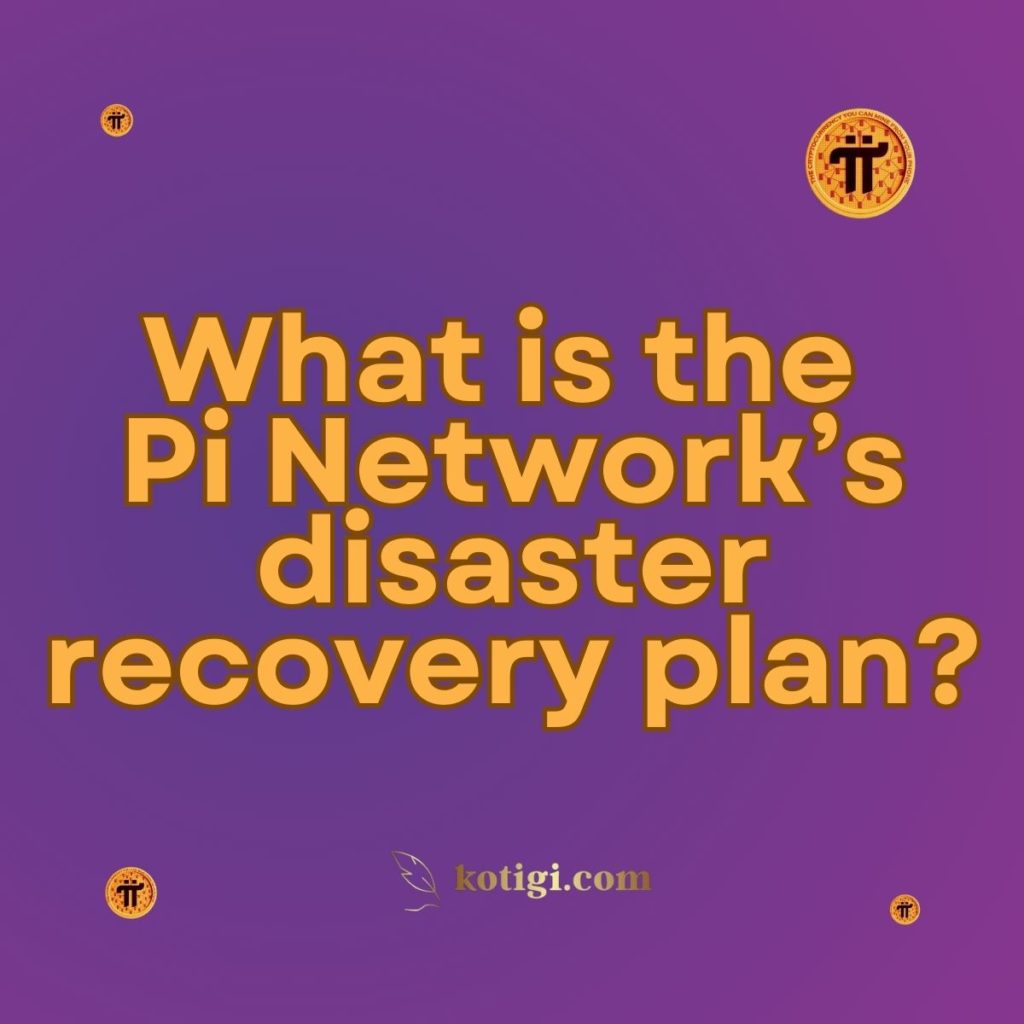
What is the Pi Network’s disaster recovery plan?
The Pi Network’s disaster recovery plan ensures operational continuity through regular data backups, a redundant infrastructure, and a dedicated incident response team, allowing for quick recovery from disruptions.
Introduction
In today’s fast-paced digital environment, the need for robust disaster recovery plans has never been more critical, especially for platforms dealing with sensitive data and financial transactions like Pi Network. As a cryptocurrency network designed to facilitate accessible digital currency for everyone, Pi Network must ensure its operations remain uninterrupted, even in the face of unforeseen challenges. This post delves into the intricacies of Pi Network’s disaster recovery plan, exploring its components, strategies, and overall importance to the platform’s resilience and reliability.
Understanding Disaster Recovery
Disaster recovery refers to the processes and policies that organizations put in place to protect their critical operations from significant disruptions. This includes a wide range of potential incidents, from natural disasters and technical failures to cyberattacks. A comprehensive disaster recovery plan ensures that an organization can swiftly return to normal operations with minimal downtime.
The Importance of a Disaster Recovery Plan
A well-structured disaster recovery plan is essential for several reasons:
- Data Protection: Cryptocurrency platforms handle sensitive user data and financial information, making it crucial to protect this data from loss or corruption during a disaster.
- Business Continuity: Users rely on the platform for their transactions, and any interruption can lead to financial losses and damage to the platform’s reputation.
- Regulatory Compliance: Many jurisdictions require organizations to have disaster recovery plans in place to ensure data protection and business continuity.
- User Trust: Demonstrating preparedness for potential disruptions can enhance user confidence in the platform, fostering a loyal user base.
Types of Disasters
Understanding the types of disasters that could affect Pi Network is crucial for developing an effective disaster recovery plan.
- Natural Disasters: Events like earthquakes, floods, and storms can disrupt data center operations.
- Cyber Threats: Cybersecurity risks such as ransomware attacks, data breaches, and DDoS attacks are significant concerns.
- Technical Failures: Hardware malfunctions, software bugs, and power outages can cause significant disruptions.
Goals of Disaster Recovery
The goals of a disaster recovery plan should align with the broader business objectives of Pi Network.
- Minimize Downtime: The primary objective is to reduce downtime and ensure that services remain available to users.
- Ensure Data Integrity: Preserving the integrity and confidentiality of user data during a disaster is paramount.
- Maintain Operational Efficiency: The plan should allow for a smooth transition back to normal operations without major disruptions.
Components of Pi Network’s Disaster Recovery Plan
While specific details of Pi Network’s disaster recovery plan may not be publicly available, several key components are likely part of its strategy to ensure robust disaster preparedness.
1. Data Backup and Recovery
One of the primary elements of any disaster recovery plan is a comprehensive data backup strategy. Pi Network likely employs multiple layers of data backup to safeguard user information and transaction records.
- Regular Backups: Data is likely backed up regularly to ensure that the most current information is preserved. This may involve incremental backups, capturing only changes made since the last backup, to minimize storage use and recovery time.
- Off-site Storage: Backups are often stored in secure off-site locations, either physically or in the cloud, to protect against data loss due to local disasters.
- Data Integrity Checks: To ensure that backups are reliable, Pi Network may implement regular integrity checks to verify the accuracy and completeness of backed-up data.
2. Redundant Infrastructure
To enhance resilience, Pi Network is likely to utilize a redundant infrastructure strategy, which involves duplicating critical systems and components.
- Multiple Data Centers: By employing multiple data centers across different geographic locations, Pi Network can ensure that, in the event of a disaster affecting one center, operations can seamlessly shift to another center without significant disruption.
- Load Balancing: Utilizing load balancing techniques can distribute user traffic across different servers or data centers, preventing any single point of failure.
- Failover Systems: Implementing automatic failover systems can quickly reroute traffic and operations to backup systems in the event of a failure.
3. Incident Response Team
A dedicated incident response team is vital for executing disaster recovery plans efficiently.
- Preparedness Training: Team members should undergo regular training to stay updated on the latest disaster recovery practices and technologies. This ensures that they can respond effectively when a disaster occurs.
- Clear Roles and Responsibilities: Defining roles and responsibilities within the incident response team can facilitate quicker decision-making and coordination during a crisis.
- 24/7 Monitoring: Continuous monitoring of systems can help identify potential threats and issues before they escalate into significant problems.
4. Communication Plans
Effective communication is essential during a disaster to keep all stakeholders informed.
- User Notifications: Pi Network likely has protocols in place to inform users of any service interruptions or issues, including updates on recovery efforts.
- Internal Communication: Keeping the internal team informed is crucial for coordinated recovery efforts. Clear communication channels should be established to share updates and directives.
- Stakeholder Engagement: Engaging with external stakeholders, such as investors and partners, during a disaster can help maintain trust and transparency.
Strategies for Effective Disaster Recovery
1. Risk Assessment and Management
An effective disaster recovery plan starts with a thorough risk assessment to identify potential threats and vulnerabilities. Pi Network would need to analyze risks associated with various types of disasters.
- Natural Disasters: Earthquakes, floods, and storms can impact data center operations.
- Cyber Threats: Ransomware attacks, data breaches, and other cybersecurity threats are significant concerns for cryptocurrency platforms.
- Technical Failures: Hardware malfunctions or software bugs can disrupt service availability.
2. Testing and Drills
Regular testing of disaster recovery plans is vital to ensure their effectiveness.
- Simulation Drills: Conducting simulation drills can help the incident response team practice their response to various disaster scenarios, allowing them to refine their approach.
- Plan Review and Updates: Following testing, the disaster recovery plan should be reviewed and updated based on the outcomes to address any weaknesses identified during drills.
- User Feedback: Gathering feedback from users after a disaster recovery drill can provide insights into areas for improvement.
3. Collaboration with Third-Party Providers
Many organizations partner with third-party providers for additional resources and expertise in disaster recovery.
- Cloud Services: Pi Network may leverage cloud services to enhance its backup and recovery capabilities. Cloud providers often have advanced infrastructure designed for resilience and redundancy.
- Consultation with Experts: Engaging disaster recovery experts can provide valuable insights and help Pi Network optimize its plan based on industry best practices.
- Third-Party Risk Management: Assessing the risks associated with third-party providers is essential to ensure that they meet the necessary standards for disaster recovery.
The Role of Decentralization in Disaster Recovery
One of the unique aspects of Pi Network is its decentralized architecture. This approach has implications for disaster recovery that set it apart from traditional centralized platforms.
1. Enhanced Resilience
Decentralization inherently improves resilience. In a decentralized network, there is no single point of failure, which means that if one node or data center goes down, the rest of the network can continue to operate.
- User Nodes: In Pi Network, users contribute to the network by running nodes on their devices. This means that the network’s operation relies on the collective resources of its users, making it less vulnerable to localized disruptions.
- Peer-to-Peer Technology: Utilizing peer-to-peer technology allows for data sharing and communication across the network, ensuring continued operation during partial outages.
2. Data Distribution
Decentralization allows for the distribution of data across multiple nodes, enhancing data integrity and availability.
- Redundancy: Data can be replicated across various nodes, ensuring that if one node experiences a failure, the data remains accessible from other nodes.
- Increased Security: A decentralized network can also be more secure against certain types of attacks, such as DDoS attacks, as it is harder to target a distributed network compared to a centralized one.
- User Empowerment: By decentralizing data control, users have more agency over their information, enhancing trust in the platform.
3. Adaptation to Changes
Decentralization allows Pi Network to adapt quickly to changes in the environment or user needs.
- Scalability: The decentralized nature allows for easy scalability, enabling the network to grow and accommodate more users without overwhelming a central system.
- Flexibility: A decentralized structure can provide more flexibility in how disaster recovery measures are implemented across various nodes.
Importance of Continuous Improvement
Disaster recovery is not a one-time effort but an ongoing process that requires regular evaluation and improvement.
1. Learning from Past Incidents
Analyzing past incidents can provide valuable insights into areas for improvement.
- Post-Incident Reviews: Conducting reviews after any disruptions can help identify gaps in the disaster recovery plan and inform future enhancements.
- User Feedback: Incorporating user feedback can provide perspectives on their experiences during disruptions and recovery efforts.
2. Adapting to Changing Environments
The landscape of technology, cybersecurity, and business operations is constantly evolving.
- Emerging Threats: As new threats emerge, Pi Network must adapt its disaster recovery plan to address these challenges effectively.
- Technological Advancements: Keeping abreast of technological advancements can enhance the efficiency and effectiveness of disaster recovery strategies.
3. Regular Plan Reviews
The disaster recovery plan should be reviewed regularly to ensure its relevance and effectiveness.
- Stakeholder Input: Engaging stakeholders in the review process can provide diverse perspectives and recommendations for improvement.
- Compliance Updates: Keeping the plan aligned with regulatory changes is essential for ensuring compliance.
Conclusion
Pi Network’s disaster recovery plan is a crucial component of its operational strategy, ensuring the platform’s resilience and reliability in the face of potential disruptions. By focusing on data backup and recovery, implementing redundant infrastructure, and maintaining clear communication channels, Pi Network can effectively navigate challenges and minimize downtime.
Moreover, the decentralized nature of the network enhances its resilience, allowing it to maintain operations even when individual nodes experience failures. As Pi Network continues to grow, ongoing evaluation and improvement of its disaster recovery plan will remain essential to safeguarding user trust and ensuring a seamless user experience.
Key Takeaways:
- Pi Network’s disaster recovery plan is essential for protecting user data and ensuring service continuity.
- Key components likely include data backup and recovery, redundant infrastructure, and a dedicated incident response team.
- Risk assessment, testing, and collaboration with third-party providers enhance the effectiveness of the disaster recovery plan.
- Decentralization plays a significant role in enhancing resilience and data availability.
- Continuous improvement is vital to adapt to changing environments and emerging threats.





